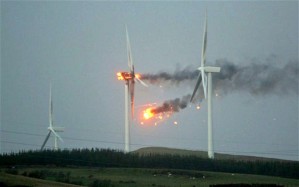
Warm yourself by the heat from this burning wind turbine…
Greens: We must build wind farms to save the planet!
Also Greens: We must not build wind farms to save endangered birds!
Unprincipled to the highest degree, the Greens will relentlessly push for damaging environmental action like wind farms and massive solar arrays… as long as it’s for other people.
Total hypocrites.
Environmentalists are supposed to like wind farms. They provide renewable energy and are seen as a key part of the energy transition as Australia attempts to lower its carbon emissions to meet its Paris Agreement obligations.
But former leader of the Greens, Bob Brown, has come out swinging against a giant new wind farm planned for Robbins Island, in the north-west corner of Tasmania.
He says it is in the wrong place, will ruin the view and kill endangered birds like the Tasmanian wedge-tail eagle and the white-breasted sea eagle that live on the island, and potentially migratory birds like the swift parrot and the orange-bellied parrot that travel between Tasmania and the mainland. (source)
Today’s challenge – find any principle or consistency in the Greens’ shrill environmental posturing. Yeah, good luck with that…





Recent Comments